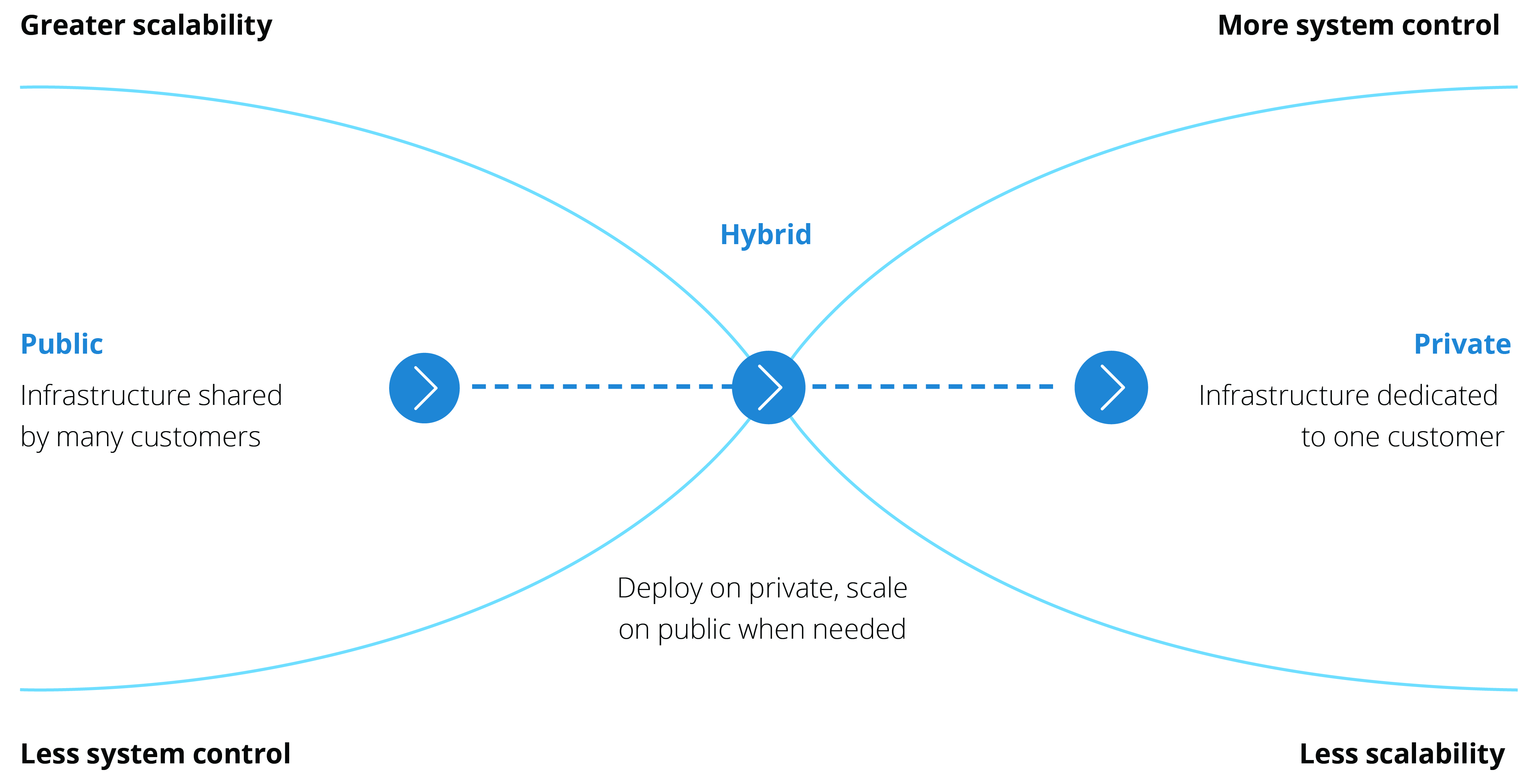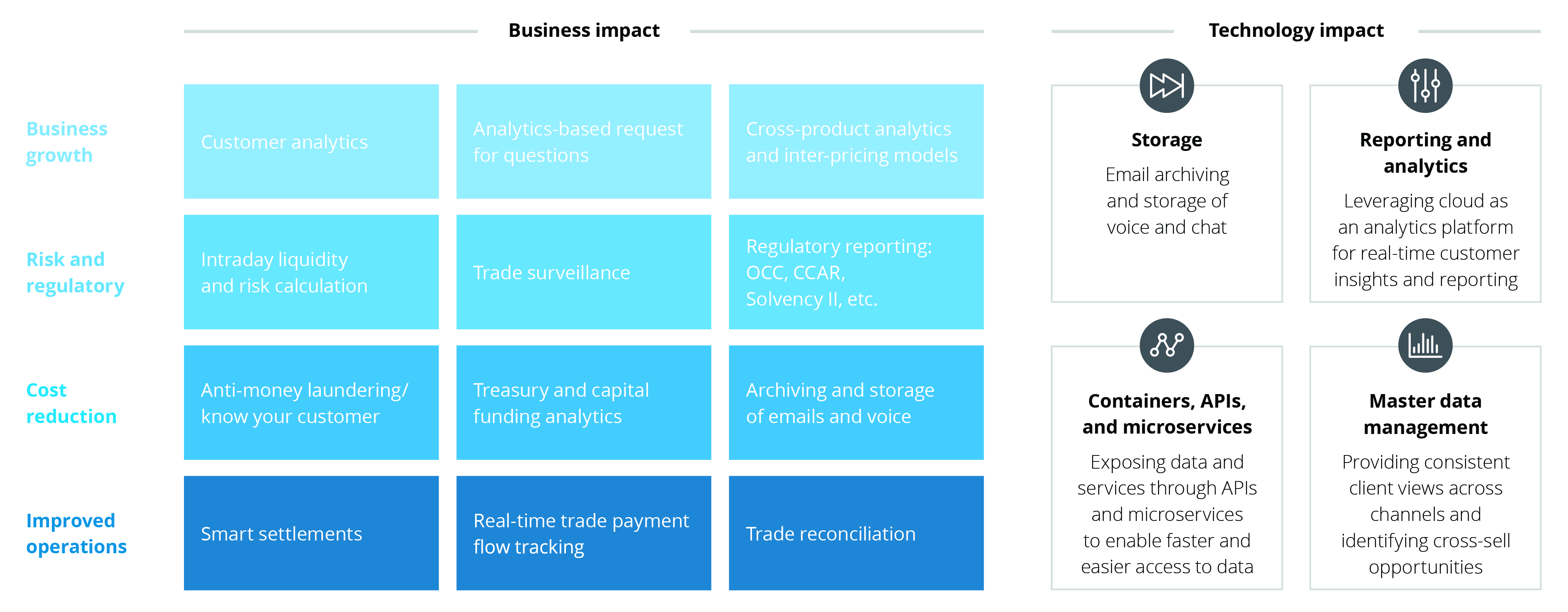Cloud banking: More than just a CIO conversation has been saved

Perspectives
Cloud banking: More than just a CIO conversation
What will financial services of the future look like with cloud?
Cloud computing is moving to the forefront as a focus for IT leaders, C-suite executives, and board members. Learn how cloud can be a catalyst for enterprise business transformation—and a potential game-changer for how financial services organizations will operate in the future.
Explore content
- Leveraging the cloud to create new business frontiers
- An enterprise-level solution
- Planning and implementing cloud solutions
- Emerging use cases in FSI
- Get in touch
Leveraging the cloud to create new business frontiers
The bank of 2030 will look very different from today. Facing changing consumer expectations, emerging technologies, and alternative business models, banks need to start putting strategies in place now to help them prepare for this future. An important indicator of the shifting landscape? Cloud computing is moving to the forefront as a focus for the chief information officer, C-suite executives, and board members.
Banking and capital markets leaders increasingly recognize that cloud is more than a technology; it is a destination for banks and other financial services firms to store data and applications and access advanced software applications via the internet.
The leading public cloud providers offer an array of innovative products-as-a-service that can be accessed on their platforms and help banks implement business and operating models to improve revenue generation, increase customer insights, contain costs, deliver market-relevant products quickly and efficiently, and help monetize enterprise data assets. The cloud also offers a huge opportunity to synchronize the enterprise; to break down operational and data silos across risk, finance, regulatory, customer support, and more. Once massive data sets are combined in one place, the organization can apply advanced analytics for integrated insights.
After years of focusing on the technology’s value as a cheaper, faster, and more “elastic” alternative to on-premise data storage, bank leaders are considering how they can leverage the cloud in three areas “above the line” to create new business frontiers and in three areas “below the line” to optimize the organization. Applying cloud technology in these six areas may help banks drive improved business performance and shareholder returns.
Critical sources of value enabled by cloud transformation:
“Above the line”—New business frontiers |
“Below the line”—Optimizing the organization |
|||
Synchronize the enterprise
|
Build resilient operations
|
|||
Drive business innovation
|
Enhance IT security
|
|||
Unleash new talent and new ways of working
|
Scale computing costs as needed
|
|||
An enterprise-level solution
Business unit and IT executives accustomed to an on-premise data center may find the prospect of upgrading or replacing legacy systems with an enterprise-level cloud solution to be quite daunting. Fortunately, banks can approach this transformation incrementally. They can mix and match hybrid and multi-cloud solutions based on their organizational needs, maturity, and readiness; most organizations choose a multi-cloud approach. Whatever the deployment model, data residing in the cloud can be as (or more) secure than it is with on-premise storage models.
Cloud deployment models
Companies can be all-in on cloud without being 100 percent cloud; they can mix and match based on needs. In each option, data can be as (or more) secure than it is with on-premise options.

Planning and implementing cloud solutions
Business case development
Not only is the cloud helping to innovate IT strategy, also it is becoming an engine to quickly build new capabilities and services to address business imperatives. Many transformative solutions (e.g., customer relationship management, finance, enterprise resource management) already are cloud-based—they are just not primarily communicated as such. A cloud business case should emphasize how the bank can cost-effectively tap into cloud-delivered solutions to drive customer insights, experiences, and offers; grow revenue; lower costs; find and onboard better talent; and provide more consistent enterprise operating platforms. It also should include a baseline cloud value-assessment model to map the economics of changing market forces, pricing, and business assumptions and aid in scenario planning. Finally, the business case should address change management issues: Cloud technology may dramatically alter certain employee roles; what steps may be needed to help adapt the organization’s culture and mind-set?
Solution design and execution
The cost and effort to migrate workloads to the cloud may be a major concern for financial institutions contemplating executing cloud strategies. Cost and time to market are key factors when companies are seeking to leverage business-building technologies such as advanced data analytics and machine learning. External cloud providers offer these and other capabilities that can shorten development time versus building capabilities in-house.
Vendor management
The banking industry will be transitioning through both hybrid and multi-cloud environments for years to come. During this lengthy period, vendors likely will be offering new, cloud-based services and capabilities on a regular basis. Financial services organizations should avoid vendor lock-in so that they can adapt to marketplace changes without having to re-platform when moving from one vendor to another. Also, as vendors mature, they may offer better pricing flexibility by leveraging different cloud platforms that enable an organization to move workloads from one cloud to another to meet business needs, and to apply best practices built on one cloud platform to departments using other cloud vendors. Adopting a multi-vendor/multi-cloud strategy can be complex and challenging; developing a common understanding of architectural components and governance strategy enables optimal use of multi-cloud environments.
Security
Data security concerns are top of mind for bank leaders. An important part of understanding the cloud is considering how an enterprise’s current infrastructure and capabilities may be limiting its ability to detect and address new risks and vulnerabilities—and how cloud technology can help. Security is different in the cloud because of the tools that are native to each cloud provider’s environment and the fact that cloud providers typically take responsibility for the security of the lower-level infrastructure layers. The shared security responsibility between cloud providers and the clients they host changes how organizations should anticipate and prepare for security risks.
Regulatory compliance
Cloud computing can help banks and financial services firms meet ever-evolving regulatory reporting requirements (e.g., Comprehensive Capital Analysis and Review, Solvency II) in multiple operating jurisdictions—a critically important capability in an industry where cross-border transactions are the norm. Cloud solutions can also help banks conduct intraday liquidity and risk calculations, and mine trade surveillance data to detect anti-money laundering and other fraud issues. A cloud platform enables data-brokering placement capabilities based on data criticality and Certified Safety Professional certifications.
Emerging use cases in FSI
From 2016 to 2018, Deloitte Global saw a threefold increase in the number of organizations adopting cloud to promote innovation. As might be expected, the chief information officer/chief technical officer is the primary driver of a cloud transformation, followed by the chief executive officer and business leadership. Companies across the global financial services industry have been on the public cloud journey for the last three-to-five years, with tremendous acceleration over the past 12–18 months.
- A global financial services firm and one of the largest banks in the United States began using a platform-as-a-service private cloud five years ago. It evaluated public cloud providers in 2016 and currently has two wholesale trading apps on a public cloud.
- A leading investment bank has been using a public cloud provider for regulatory reporting solutions. It is conducting pilots with two vendors for a cloud-based infrastructure-as-a-service solution.
- A major bank in North America currently is on a private cloud and getting its feet wet on public cloud, primarily using software-as-a-service and infrastructure-as-a-service. The bank expects to be multi-cloud in the next four years.
Technology spend levels and growth projections confirm that cloud computing is the most important force shaping the market for technology services. Across the global financial services industry, organizations are leveraging private, public, and hybrid cloud solutions to create innovative products and services, fuel enterprise transformation, and redefine the “art of the possible.” For additional Deloitte insight on cloud computing, see the Wall Street Journal article, “Why cloud is on the board’s agenda.”
If you want to learn more about how your bank can use cloud technology as the catalyst for enterprise transformation, please contact us.
Further recommendations
Bank of 2030: Transform boldly
The future of banking will look very different from today. Faced with changing consumer expectations, emerging technologies, and new business models, banks will need to start putting strategies in place now to help them prepare for banking in 2030. How can you drive bold transformation in your organization over the next 10 years?

For more information, please contact:
Michael Tang |
|
Recommendations
Bank of 2030: Transform boldly
Future of banking


